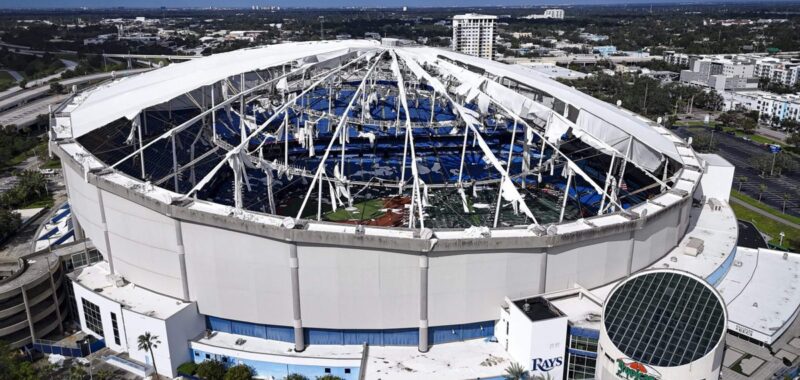In the days before Hurricane Milton, top officials at one of the firms that built Tropicana Field grew “concerned” that the stadium’s roofing might not hold up against the historic winds forecasted for the Tampa Bay area. That concern proved prescient, as videos surfaced Wednesday evening of the roof of the Tampa Bay Rays’ home field being ripped away, leaving the once-domed stadium in St. Petersburg, Fla., exposed.
The roof had never been replaced in the more than 34 years since it was installed, despite being “well past its intended service life,” according to David Campbell, a principal at Geiger Engineers, the group that installed the roof for the stadium’s opening in 1990. He said the Teflon fabric’s service life is approximately 25 years.
“They plan to be in a new building in the not-too-distant future. And they were hoping, I think, to make it,” Campbell said, noting that while it was a “significant storm” the fabric was designed to “safely resist” the damage it nonetheless withstood.
“But,” he added, “the fabric is very, very old now.”
The team plans to begin construction on a new ballpark on an adjacent site in St. Petersburg in 2025, with hopes to open Gas Plant Stadium by Opening Day in 2028.
As for how long it would take to repair Tropicana Field’s roof, Campbell said it remains too early to give a specific timeline, mostly because it would depend on whether the primary structure of the venue sustained any significant damage. While he said the strut and cable networks “appear to be fine,” a more thorough condition assessment would be required to determine an accurate schedule for repair.
The Rays open the next season at home in less than six months, on March 27. It is unclear if the damage sustained on Wednesday could be fixed before the season begins.
Though the team issued a statement, it declined to comment on issues related specifically to the roof, or any potential structural damage to the venue. The City of St. Petersburg, which owns Tropicana Field, also declined to comment on the roof, saying in a written statement: “we are tremendously grateful that no one was injured at Tropicana Field. In the coming days and weeks, the city will work with the Tampa Bay Rays to thoroughly assess the condition of the ballpark and chart a path forward.”
Campbell was a part of the team that constructed the roof nearly four decades ago. He clarified that while there were no “life safety concerns” related to keeping the aging fabric, the wear and tear through the years would make it more susceptible to significant damage in a high wind event.
The Rays, who operate the ballpark, said that only essential personnel were at the venue on Wednesday evening and were all safe and accounted for as of Thursday morning as the Category 3 hurricane passed. Contrary to initial reports, the Rays said that the ballpark was not being used as a shelter during the storm.
To our Rays family, fans and the entire Tampa Bay community. 💙 pic.twitter.com/X9fwjZdcRX
— Tampa Bay Rays (@RaysBaseball) October 10, 2024

Drone shots of the interior of Tropicana Field following the storm. (Miguel J. Rodriguez Carrillo / AFP via Getty Images)
According to the Rays, Tropicana Field’s roof was made of six acres of translucent, Teflon-coated fiberglass. It was similar to the fiberglass fabric roof of the Hubert H. Humphrey Metrodome, which once stood in Minneapolis and collapsed due to snow in 2010. Replacing the Metrodome roof took five months and cost $23 million. Campbell said that Tropicana Field has a similar size but fewer panels. That could make for a quicker installation, though that’s not guaranteed.
“It could be done, if the primary structure is serviceable,” Campbell said. “We could have the dome re-enclosed in five or six months.”
Geiger has remained a consultant on numerous topics with Tropicana Field over the years, Campbell said, on everything from maintaining safety for World Wrestling Entertainment events involving the roof to replacing the center cupola, a small structure at the center top of the dome. Campbell said the Rays have used other firms to inspect the fabric, but that he’s reviewed their reports.
“The loading from high winds, in conjunction with damage to the fabric, is difficult for tension membrane,” Campbell said when asked what he took from those reports. “And the older it is, especially as it gets very advanced in its life, the tear strength diminishes — essentially, its resistance to small tears propagating. That’s known by everyone in the industry.”
According to the Rays’ 2024 media guide, Tropicana Field’s roof was able to sustain 115 mph winds. Gusts reached about 105 mph on Wednesday evening. Campbell noted, however, that the methodology of measuring wind speed has changed since the stadium was built. That means it’s hard to say whether Hurricane Milton’s winds were stronger than what the facility was expected to handle.
Still, Campbell said he believes that the roof, in new condition, was built to sustain those aforementioned 115 mph winds. It was initially designed to handle the weather it faced on Wednesday.
“Losing fabric does not create a life safety scenario at all,” Campbell said. “It creates the potential for damage … It’s not really surprising you’d try to get by as long as you could. I can’t question that.”
The Rays said in their statement that it will take weeks to assess the damage caused by the storm. And because of that, it remains too early to tell how long this rebuilding project will take.
(Top Photo: Miguel J. Rodriguez Carrillo / AFP via Getty Images)

